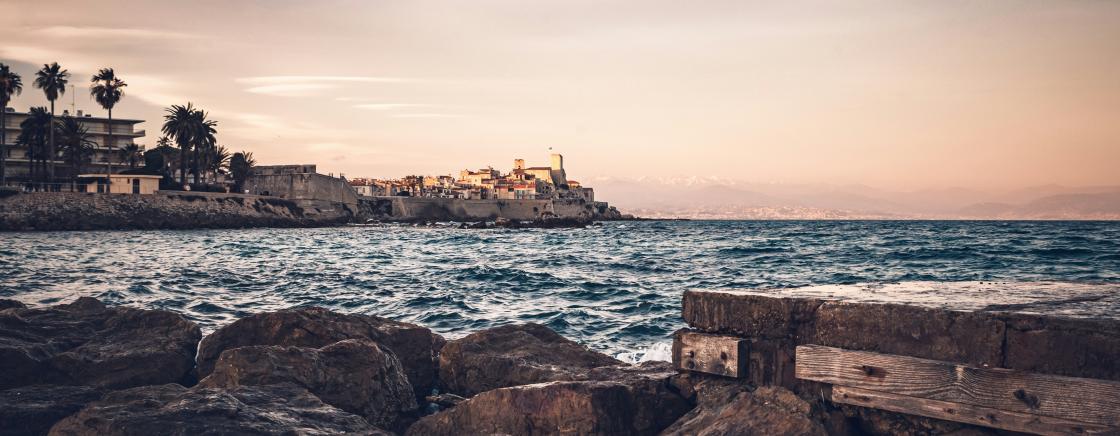
A Village Within the City: The Soul of Antibes
As soon as you step through the gates of the old town, a sense of calm sets in. There are no wide boulevards or towering buildings here, just narrow cobbled streets lined with soft yellow, faded pink, and sun-warmed ochre facades. Wooden shutters, often slightly open, hint at the quiet rhythms of local life. You’ll see residents carrying bread from the bakery, children playing in shaded squares, and lazy cats lounging on window ledges. The atmosphere is warm and village-like, inviting you to slow down. Antibes seems to have found the perfect balance between tradition and modern living.

The Provençal Market: A Burst of Flavors
One of the beating hearts of Old Antibes is undoubtedly its covered market, tucked under the halls of Cours Masséna. Every morning (except Mondays), the stalls overflow with color and fragrance: tomatoes, olives of all kinds, fresh herbs, goat cheese, pissaladière, socca, tapenade… The market isn’t just a place to shop, it’s a place to meet, share, and experience local life. People come to fill their baskets, exchange a few words, enjoy a coffee on a terrace, or simply wander through the scents of the South.

The Ramparts and the Sea: A Scenic Outlook
Old Antibes wouldn’t be the same without its ramparts, impressive 16th-century walls that run along the shoreline. Walking along them offers breathtaking views over the bay, with the Alps faintly visible in the distance. In some spots, the sea almost touches the old stone, creating a striking contrast between raw nature and historic architecture. It’s the perfect setting for a romantic walk at sunset. Curious visitors can stop at the Saint-Jaume bastion platform to admire the monumental sculpture Le Nomade by Jaume Plensa, facing the horizon like a silent guardian of the city.

Hidden Streets and Subtle Art
Away from the grand galleries of the Riviera, Old Antibes offers a quieter, more personal artistic scene. Many galleries are tucked into small side streets, where painters, ceramicists, and photographers display their work. Art seems to emerge from the walls themselves, in a painted door, a subtle piece of graffiti, or a carefully curated window. Picasso’s presence still lingers here; the artist stayed at Château Grimaldi in 1946, now home to the Picasso Museum, a must-visit to understand his deep connection to the city. Inside, the works are as impressive as the terrace view overlooking the sea.

Port Vauban and Its Contrasts
Leaving the ramparts behind, you’ll reach Port Vauban, one of Europe’s largest port. The contrast is striking, after the rustic charm of the old quarter, the eye is drawn to the luxurious yachts and sleek sailboats docked in the harbor. Yet despite its modern appearance, the port retains its authenticity: fishermen still tie up their colorful pointus along the fisherman’s quay, and you can even buy fresh catch in the early morning. Blending luxury and tradition, the port perfectly reflects Antibes' dual spirit, where different worlds coexist harmoniously.

Terraces and the Art of Living
It’s hard to talk about Antibes without mentioning its local cuisine and the relaxed lifestyle that goes with it. Old Antibes is full of charming spots, family-run bistros, fine dining restaurants, artisanal ice cream parlors... Here, people settle into terraces to enjoy a glass of rosé, a plate of fried zucchini flowers, or a fig-flavored gelato. Summer evenings come alive with music, guitar melodies, laughter, and a genuine sense of human warmth. Antibes lives by night too, but always with a spirit of simple joy rather than flashiness.
Wandering through Old Antibes feels like stepping into a world where time slows down. Every stone, every facade, every detail tells a story. Between sea and ramparts, between art and tradition, this district beautifully embodies Mediterranean authenticity. Whether you're coming for a walk, a romantic getaway, a gourmet break, or a cultural discovery, Old Antibes always leaves a lasting impression.
